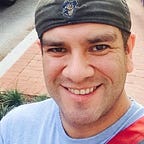Essays on HIV/AIDS: Introduction — Sliding into my DM’s
A series of informal essays in collaboration with Until There’s A Cure Social Media Affiliate Program
SLIDING INTO MY DMS
A few weeks ago, I got an Instagram DM (Direct Message) asking me if I’d be interested in joining a brand’s social media affiliate program.
“…we think you’d be the perfect fit” read the message.
If this were a chance in-person encounter the first thing out of my mouth would have been, are you talking to me? Followed by, are you sure?
I’m not exactly what I’d consider an “influencer.” If anything I’m the guy who might influence you into having another piece of cake or, to my friends’ chagrin, another White Claw. And let’s just say the number of followers that I have are a tad below Taylor Swift’s…off by a couple of million — in cat years. I’m also not a fashion or fitness blogger as evident by the geek tee shirts and merchandise you’ll find on my Insta. And if I’m being honest, the amount of food pics on my account is currently influencing me to consider getting on a diet.
Ultimately it wasn’t a fashion brand reaching out to me, but rather a non-profit org dedicated to raising funds for HIV/AIDS — Until There’s a Cure (UTAC). Started in 1993, UTAC has the distinction of being the first org to use a bracelet raising both funds and awareness for HIV/AIDS. The original silver wrist cuff (The Bracelet), was created by Italian designer Isabel Geddes, and featured the HIV/AIDS ribbon. I actually owned the cuff at one point in my life but I can’t remember if it was a gift or something I purchased online in the early 2000s. So although I knew of the bracelet I didn’t know about the organization per se.
Fast forward from the 2000s to 2017, I was at my bar gig in DC where an HIV/AIDS convention was taking place and there I was chatting with a stranger who was in town for meetings. Her name was Nora Hanna, and she was representing UTAC. I don’t remember our conversation but growing up in the Bay Area during the beginnings and height of the AIDS epidemic, I was well versed with HIV/AIDS related issues. And I’m sure I told her I once owned the original bracelet. By the end of our meeting, she gifted me a beaded bracelet, made with translucent green beads along with black beads painted with red/yellow markings. I believe it had been handcrafted in Africa and she explained the sale of one bracelet pays for a month’s worth of HIV/AIDS medication for victims in Ghana. I suddenly felt guilty for not paying for this generous gesture.
With Covid19 currently ravaging the nation HIV/AIDS has been in my mind the last couple of months. I was a kid when the AIDS epidemic began and AIDS was something I’d see on the news or learned in health classes. And now, a new pandemic overwhelms the planet. I wondered, is this what AIDS was like? The uncertainty of how it’s transmitted, an administration choosing to ignore the reality of this invisible killer, and strangers looking at one another at grocery stores…do they have it? It was with these thoughts in mind that I responded to the UTAC DM, agreeing to join the social media team letting them know that although they offer incentives through the program, I’m not entirely sure my posts will cause product to fly off the shelves. However as a creative — doc filmmaker, and digital creator perhaps I could use social media and offer something a little different on my platform. Something integrating the UTAC brand, jewelry, HIV/AIDS history/research, and the current pandemic as I’m not only seeing parallels between HIV/AIDS and Covid19 but seeing the names of experts that were at the front lines of HIV/AIDS now at the forefront of Covid19. This will be a learning experience but I figure at most I can bring awareness about the work that UTAC does and at the very least post about cool jewelry making a difference for people living with HIV/AIDS around the globe.
The original post from my Instagram from 2017 featuring the Sankofa Bracelet made of clay, stone, and recycled glass beads. The bracelets are handcrafted by villagers in Ghana who tested positive for HIV. Each bracelet funds both access to HIV treatment and supplemental income for its maker for one month, improving their health and status as contributing members of their community. You can find this design and many others at UTAC’s online store. https://store.until.org
